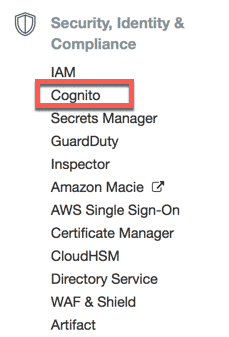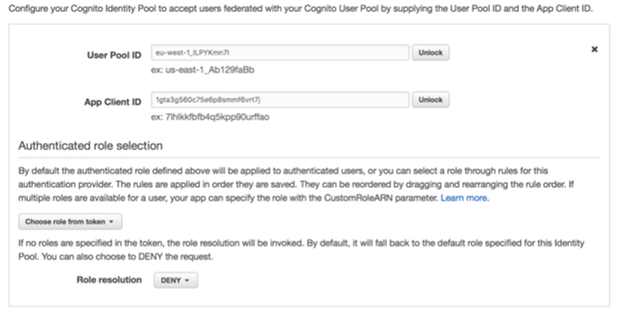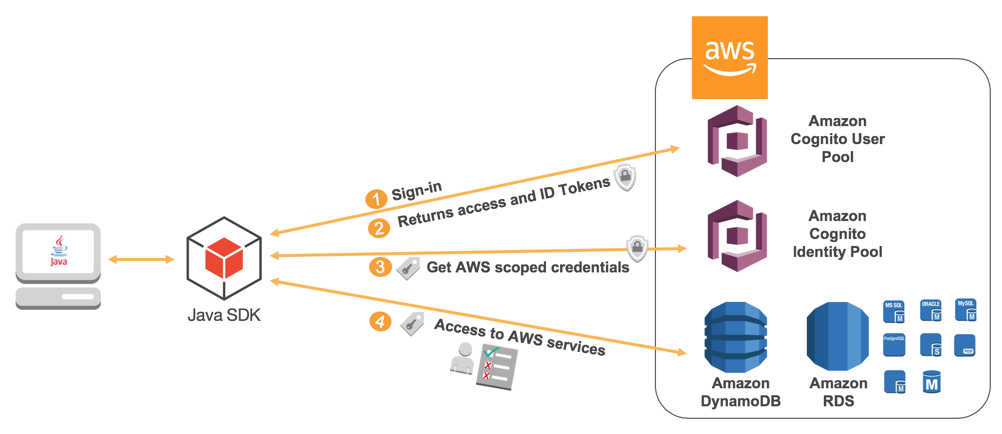Get User Email Cognito Login Example Java Updated FREE
Get User Email Cognito Login Example Java
In this developer tutorial, nosotros are going to larn how to make an integration with Amazon Cognito using the Amazon Spider web Services software development kit (AWS SDK) for Java by providing some code samples and documentation. We are going to leverage AWS to integrate authentication and dominance into a Java web application, in addition to using groups in Amazon Cognito user and identity pools to obtain temporary identity and access management (IAM) credentials in the application.
Permit'south start from the first.
What is Amazon Cognito?
Amazon Cognito is a simple user identity and data synchronization service that provides hallmark, dominance and user management, helping us securely manage app data across applications for our users. Amazon Cognito allows usa to control permissions for different users' groups in our applications to ensure that they have appropriate admission to dorsum-end resources co-ordinate to the group they vest to.
Main components

Steps to attain hallmark and potency with Cognito
- Sign in to the Amazon Cognito console .
- Go to AWS and find Cognito under the 'Security, Identity & Compliance' section.

- On the 'Your User Pools' folio, choose 'Create a User Pool.'

- Create an identity puddle and configure it to integrate with the user pool.

- Create an IAM office and add a specific AWS admission.
- Create a group in the user puddle and map information technology to the new IAM role.

Integrating Cognito with Java
The main Cognito Java classes we will exist using in our Java application are:
- AWSCognitoIdentityProvider: The AWSCognitoIdentityProvider class allows u.s.a. to execute a lot of actions, some of the most useful being:
- Add together Custom Attributes
- Admin Add User to Group
- Admin Confirm Sign Up
- Admin Create User
- Admin Delete User
- Admin Reset User Countersign
- Admin Initiate Auth
- Admin Enable User
- Change Password
- Create Grouping
- Delete User
- Delete Group
- Delete User
- Forgot Password
- Get User
- Global Sign Out
- List Groups
- List Users
- Sign Up
- Update Grouping
- Update User Attributes
- … More
You lot can see the entire API Reference here .
- ClasspathPropertiesFileCredentialsProvider: Of all the different AWS credentials providers, we are only going to be using the ClasspathPropertiesFileCredentialsProvider in this guide.
In order to use this form, we need to create an AwsCredentials.properties file in our classpath. The file should look like this:

Allow's code
We are going to be creating a Maven web project in Java.
To start with the integration, we have to declare the AWS SDK dependencies in the pom.xml of our project.
Maven dependencies:
<dependency> <groupId>com.amazonaws aws-java-sdk 1.11.360 com.amazonaws aws-coffee-sdk-core 1.eleven.360 com.amazonaws aws-coffee-sdk-cognitoidp ane.11.360
The 2d pace is to create our AWSCognitoIdentityProvider using the credentials we have in the AwsCredentials.backdrop file.
Important: When you lot see a call to a Cognito Config, information technology is a call to a property file that has the following information:
clientId = 2jkihs1a8su8n4jq0lvihsh3po userPoolId = us-eastward-1_3vocxnITQ endpoint = cognito-idp.us-due east-1.amazonaws.com region = us-east-one identityPoolId = us-east-1:f2810be3-a906-4a1e-83bc-aa1230b6789 public AWSCognitoIdentityProvider getAmazonCognitoIdentityClient() { ClasspathPropertiesFileCredentialsProvider propertiesFileCredentialsProvider = new ClasspathPropertiesFileCredentialsProvider(); return AWSCognitoIdentityProviderClientBuilder.standard() .withCredentials(propertiesFileCredentialsProvider) .withRegion(cognitoConfig.getRegion()) .build(); } Once we have divers the Cognito customer, we can start calling the API services. Let'south look at how to sign up, sign in, add together a user to a group, modify a user's password and brand a 'become user info' API request.
Sign Up Implementation

While implementing the 'sign upward' functionality, you go a set of default attributes; these attributes in Cognito are chosen 'standard attributes.' In add-on to these, Cognito also allows you to add custom attributes to your specific user puddle definition in the AWS console.
These are the Cognito standard attributes: address, birthdate, email, family name, gender, given name, location, eye name, concluding proper noun, nickname, telephone number, moving picture, preferred username, profile, fourth dimension zone, 'updated at' time, and website.
In this sign-upwards implementation example, we are going to be using ii custom fields: the company position and the company name.
public static UserType signUp(UserSignUpRequest signUpRequest){ AWSCognitoIdentityProvider cognitoClient = getAmazonCognitoIdentityClient(); AdminCreateUserRequest cognitoRequest = new AdminCreateUserRequest() .withUserPoolId("us-east-1_Qqtfujski") .withUsername(signUpRequest.getUsername()) .withUserAttributes( new AttributeType() .withName("email") .withValue(signUpRequest.getEmail()), new AttributeType() .withName("proper noun") .withValue(signUpRequest.getName()), new AttributeType() .withName("family_name") .withValue(signUpRequest.getLastName()), new AttributeType() .withName("phone_number") .withValue(signUpRequest.getPhoneNumber()), new AttributeType() .withName("custom:companyName") .withValue(signUpRequest.getCompanyName()), new AttributeType() .withName("custom:companyPosition") .withValue(signUpRequest.getCompanyPosition()), new AttributeType() .withName("email_verified") .withValue("true")) .withTemporaryPassword("!j8fkxv2oTjLEMd") .withMessageAction("SUPPRESS") .withDesiredDeliveryMediums(DeliveryMediumType.EMAIL) .withForceAliasCreation(Boolean.Fake); AdminCreateUserResult createUserResult = cognitoClient.adminCreateUser(cognitoRequest); UserType cognitoUser = createUserResult.getUser(); render cognitoUser; } With Message Action: If the message action is not set, the default is to send a welcome message via email or phone (SMS). The welcome message includes custom sign upwardly instructions, the username, and a temporary password. When we execute the withMessageAction suppress option, Amazon Cognito volition not send any email, and in this case, the user will be in the FORCE_CHANGE_PASSWORD state until they sign in and modify their password.
With Temporary Password: This parameter is not required, and if you lot don't specify a value, Amazon Cognito generates one for you. In the example shown, nosotros defined a temporary countersign.
With Desired Commitment Mediums: This parameter is not required; if you don't specify a value, the default value is "SMS." In this case, we chose 'email,' but if nosotros want, we can select both email and SMS.
With Strength Alias Cosmos: This parameter is not required and is only used if the 'phone number verified' or the 'email verified' attribute is set to 'true.' Otherwise, it is ignored. If nosotros gear up this to 'true,' and the specified phone number or email address already exists as an allonym with a different user, the API call is going to migrate the alias from the existing user to the newly created user.
Sign In Implementation
In this example, nosotros are going to call ii functions of the AWS Cognito Identity Provider. First, we are going make the 'Admin Initiate Auth Request,' and if the user is on the FORCE_CHANGE_PASSWORD status, we are going to call the 'Admin Respond To Auth Challenge.'
The Admin Initiate Auth Request: This initiates the hallmark catamenia as an administrator. If the activity is successful, it returns an authentication response with an access token, 'expires in' time, ID token, refresh token and a token type. If the request needs some other challenge earlier information technology gets the token'south challenge proper name, the challenge parameters and session are returned.
The Admin Respond To Auth Challenge Asking: This responds to an authentication challenge as an administrator. It requires the challenge name, the client ID, the user pool ID, the session, and the claiming responses. If the activeness is successful, information technology returns an authentication response with an access token, 'expires in' time, ID token, refresh token and a token type.
They are a lot of challenge types, such as:
- MFA_SETUP: If Multi-Factor Hallmark (MFA) is required, users who do not have at least one of the MFA methods prepare are presented with an MFA_SETUP challenge. The user must set upwardly at least i MFA type to continue authenticating.
- SELECT_MFA_TYPE: This selects the MFA type. Valid MFA options are SMS_MFA for MFA via SMS, and SOFTWARE_TOKEN_MFA for TOTP software token MFA.
- SMS_MFA: The next claiming is to supply an SMS_MFA_CODE delivered via SMS.
- PASSWORD_VERIFIER: The following challenge is to supply PASSWORD_CLAIM_SIGNATURE, PASSWORD_CLAIM_SECRET_BLOCK, and TIMESTAMP after the client-side SRP calculations.
- CUSTOM_CHALLENGE: This is returned if your custom authentication flow determines that the user should pass another claiming before tokens are issued.
- DEVICE_SRP_AUTH: If device tracking was enabled in your user pool, and the previous challenges were passed, this challenge is returned so that Amazon Cognito tin kickoff tracking the device.
- DEVICE_PASSWORD_VERIFIER: This is similar to PASSWORD_VERIFIER, but for devices only.
- ADMIN_NO_SRP_AUTH: This is returned if yous need to authenticate with USERNAME and PASSWORD direct. An app customer must be enabled to use this flow.
- NEW_PASSWORD_REQUIRED: This is for users who are required to change their passwords after a successful start login. This challenge should be passed with NEW_PASSWORD and whatever other required attributes.
In this case, we are going to respond to the 'new password required' challenge blazon, and then we are going to transport the username, the previous countersign and the new password equally the challenge response.
public SpringSecurityUser signIn(AuthenticationRequestauthenticationRequest){ AuthenticationResultType authenticationResult = null; AWSCognitoIdentityProvider cognitoClient = getAmazonCognitoIdentityClient(); final Map<Cord, String>authParams = new HashMap<>(); authParams.put(USERNAME, authenticationRequest.getUsername()); authParams.put(PASS_WORD, authenticationRequest.getPassword()); terminal AdminInitiateAuthRequest authRequest = new AdminInitiateAuthRequest(); authRequest.withAuthFlow(AuthFlowType.ADMIN_NO_SRP_AUTH) .withClientId(cognitoConfig.getClientId()) .withUserPoolId(cognitoConfig.getUserPoolId()) withAuthParameters(authParams); AdminInitiateAuthResult result = cognitoClient.adminInitiateAuth(authRequest); //Has a Claiming if(StringUtils.isNotBlank(issue.getChallengeName())) { //If the challenge is required new Countersign validates if it has the new password variable. if(NEW_PASS_WORD_REQUIRED.equals(result.getChallengeName())){ if(goose egg == authenticationRequest.getNewPassword()) { throw new CognitoException(messages.get(USER_MUST_PROVIDE_A_NEW_PASS_WORD), CognitoException.USER_MUST_CHANGE_PASS_WORD_EXCEPTION_CODE, result.getChallengeName()); }else{ //we however need the username final Map<String, Cord> challengeResponses = new HashMap<>(); challengeResponses.put(USERNAME, authenticationRequest.getUsername()); challengeResponses.put(PASS_WORD, authenticationRequest.getPassword()); //add the new password to the params map challengeResponses.put(NEW_PASS_WORD, authenticationRequest.getNewPassword()); //populate the challenge response final AdminRespondToAuthChallengeRequest request = new AdminRespondToAuthChallengeRequest(); request.withChallengeName(ChallengeNameType.NEW_PASSWORD_REQUIRED) .withChallengeResponses(challengeResponses) .withClientId(cognitoConfig.getClientId()) .withUserPoolId(cognitoConfig.getPoolId()) .withSession(effect.getSession()); AdminRespondToAuthChallengeResult resultChallenge = cognitoClient.adminRespondToAuthChallenge(request); authenticationResult = resultChallenge.getAuthenticationResult(); } }else{ //has another challenge throw new CognitoException(result.getChallengeName(), CognitoException.USER_MUST_DO_ANOTHER_CHALLENGE, result.getChallengeName()); } }else{ //Doesn't have a challenge authenticationResult = outcome.getAuthenticationResult(); } cognitoClient.shutdown(); return userAuthenticated; } Add User to Group
This method adds a specific user to a specific grouping. The request parameters for the 'Admin Add together User to Group' asking are the grouping name, the username and user pool ID.
public void addUserToGroup(Cord username, String groupname){ AWSCognitoIdentityProvider cognitoClient = getAmazonCognitoIdentityClient(); AdminAddUserToGroupRequestaddUserToGroupRequest = new AdminAddUserToGroupRequest() .withGroupName(groupname) .withUserPoolId(cognitoConfig.getPoolId()) .withUsername(username); cognitoClient.adminAddUserToGroup(addUserToGroupRequest); cognitoClient.shutdown(); } Alter User Password
This method changes the password for a specific user in a user puddle. The request parameters are the access token we received while doing the sign in, the previous countersign, and the proposed countersign.
publicvoid changePassword(PasswordRequest passwordRequest) { AWSCognitoIdentityProvider cognitoClient= getAmazonCognitoIdentityClient(); ChangePasswordRequest changePasswordRequest= newChangePasswordRequest() .withAccessToken(passwordRequest.getAccessToken()) .withPreviousPassword(passwordRequest.getOldPassword()) .withProposedPassword(passwordRequest.getPassword()); cognitoClient.changePassword(changePasswordRequest); cognitoClient.shutdown(); } Get User Info
This method retrieves all the user attributes for a specific user in a user pool equally an ambassador. The request parameters for 'Admin Get User' are the username and the user pool ID. If the activity is successful, information technology returns the user attributes, the preferred MFA settings, MFA options, and a flag indicating whether the user is enabled or not.
public UserResponse getUserInfo(String username) { AWSCognitoIdentityProvider cognitoClient = getAmazonCognitoIdentityClient(); AdminGetUserRequest userRequest = new AdminGetUserRequest() .withUsername(username) .withUserPoolId(cognitoConfig.getUserPoolId()); AdminGetUserResult userResult = cognitoClient.adminGetUser(userRequest); UserResponse userResponse = new UserResponse(); userResponse.setUsername(userResult.getUsername()); userResponse.setUserStatus(userResult.getUserStatus()); userResponse.setUserCreateDate(userResult.getUserCreateDate()); userResponse.setLastModifiedDate(userResult.getUserLastModifiedDate()); List userAttributes = userResult.getUserAttributes(); for(AttributeTypeattribute: userAttributes) { if(attribute.getName().equals("custom:companyName")) { userResponse.setCompanyName(attribute.getValue()); }else if(attribute.getName().equals("custom:companyPosition")) { userResponse.setCompanyPosition(aspect.getValue()); }else if(aspect.getName().equals("electronic mail")) { userResponse.setEmail(attribute.getValue()); } } cognitoClient.shutdown(); return userResponse; } Authentication and Authorization Flow
Once we take signed in to Amazon Cognito, it returns 3 JSON Spider web Tokens: the token ID, the access token, and the refresh token. In this office, I'yard going to explicate how we can utilise the token ID as a bearer access token in our Java Spider web Awarding.

Menstruation details:
- The client authenticates confronting a user puddle.
- The user pool assigns 3 JSON Spider web Tokens (JWT) — ID, access and refresh — to the client.
- The ID JSON Web Token is passed to the identity pool, and a role is called via the JWT claims. The user receives IAM temporary credentials with privileges that are based on the IAM office that was mapped to the group that the user belongs to.
- Then, the user can make calls to other services on AWS and applications such as databases, as shown in the image. These privileges are dictated by IAM policies.
What is OAuth 2.0?
OAuth ii.0 is an authorization framework that enables applications to obtain limited admission to user accounts on a Web API. Web APIs protected by OAuth 2.0 need to validate access tokens, which tin be implemented every bit signed JSON Web Tokens.
For this implementation, we are going to use the Maven Nimbus Jose+JWT library dependency by adding the following lines to our pom.xml
com.nimbusds nimbus-jose-jwt 4.23
The Nimbus Jose+JWT library provides a framework for all the steps to validate a JSON Web Token. The JWT validation steps are:
- JWT Parsing: The admission token provided is parsed as a JWT. If the parsing fails, the token volition exist considered invalid.
- Algorithm Check: The JSON Web Key algorithm specified in the JSON Spider web Token header is checked. If a token with an unexpected algorithm is received, the token will be immediately rejected.
- Signature Bank check: In this step, the digital signature is verified.
- JWT Claims Cheque: The JSON Web Token claims set is validated; to verify JWT claims, the following steps are necessary:
- Verify that the token has not expired.
- The audition (aud) claim should friction match the app client ID created in the Amazon Cognito User Puddle.
- The issuer (iss) claim should match the user pool. For instance, a user pool created in the selected region (u.s.-east-1) has an 'iss' value of: https://cognito-idp.usa-east-1.amazonaws.com/<userpoolID>.
- Check the token_use merits.
- If you are but accepting the admission token in your Spider web APIs, its value must be 'admission.'
- If y'all are only using the ID token, its value must exist 'id.'
- If y'all are using both ID and admission tokens, the token_use claim must be either 'id' or 'access.'
- Y'all tin now trust the claims inside the token.
Implementation
- We create a ConfigurableJWTProcessor:
@Bean public ConfigurableJWTProcessor configurableJWTProcessor() throws MalformedURLException { ResourceRetriever resourceRetriever = new DefaultResourceRetriever(jwtConfiguration.getConnectionTimeout(),//2000 jwtConfiguration.getReadTimeout()//2000); //https://cognito-idp.{region}.amazonaws.com/{userPoolId}/.well-known/jwks.json. URL jwkSetURL= new URL(jwtConfiguration.getJwkUrl()); //Creates the JSON Web Key (JWK) JWKSource keySource= new RemoteJWKSet(jwkSetURL, resourceRetriever); ConfigurableJWTProcessor jwtProcessor= new DefaultJWTProcessor(); //RSASSA-PKCS-v1_5 using SHA-256 hash algorithm JWSKeySelector keySelector= new JWSVerificationKeySelector(RS256, keySource); jwtProcessor.setJWSKeySelector(keySelector); return jwtProcessor; } - We initialize the com.nimbusds.jwt.proc.ConfigurableJWTProcessor:
@Autowired private ConfigurableJWTProcessor configurableJWTProcessor;
- Then, we extract the admission token from the Authentication Header of the asking. In this case, we are going to use the Bearer JWT Access Token.
public Authentication getAuthentication(HttpServletRequest request) throws ParseException, BadJOSEException, JOSEException { Cord idToken = request.getHeader(jwtConfiguration.getHttpHeader()); if(null == idToken) { throw new CognitoException(NO_TOKEN_FOUND, CognitoException.NO_TOKEN_PROVIDED_EXCEPTION, "No token found in Http Authorisation Header"); }else{ idToken = extractAndDecodeJwt(idToken); JWTClaimsSetclaimsSet = zero; claimsSet= configurableJWTProcessor.procedure(idToken, zippo); if (!isIssuedCorrectly(claimsSet)) { throw new CognitoException(INVALID_TOKEN, CognitoException.INVALID_TOKEN_EXCEPTION_CODE, String.format("Issuer %southward in JWT token doesn't match cognito idp %due south", claimsSet.getIssuer(),jwtConfiguration.getCognitoIdentityPoolUrl())); } if(!isIdToken(claimsSet)) { throw new CognitoException(INVALID_TOKEN, CognitoException.NOT_A_TOKEN_EXCEPTION, "JWT Token doesn't seem to be an ID Token"); } String username = claimsSet.getClaims() .get(jwtConfiguration.getUserNameField()).toString(); Listing groups = (List) claimsSet.getClaims() .get(jwtConfiguration.getGroupsField()); List grantedAuthorities = convertList(groups, grouping-> new SimpleGrantedAuthority(ROLE_PREFIX+ group.toUpperCase())); User user = new User(username, EMPTY_STRING, grantedAuthorities); return new CognitoJwtAuthentication(user, claimsSet, grantedAuthorities); } } private boolean isIssuedCorrectly(JWTClaimsSet claimsSet) { return claimsSet.getIssuer().equals(jwtConfiguration.getCognitoIdentityPoolUrl()); } private boolean isIdToken(JWTClaimsSet claimsSet) { return claimsSet.getClaim("token_use").equals("id"); } Conclusions
By not implementing a user direction service on the Cloud such every bit Amazon Cognito, a programmer must go through the process of creating the user, passwords, roles, and access management platform, which consumes a lot of time and does not necessarily contribute greater value to the customer's final solution.
Amazon Cognito is a fully managed service that scales to millions of users by assigning them to standards-based groups such equally OAuth 2.0, SAML 2.0, and OpenID Connect. This allows us to have full control of the user direction in our Java application without writing any backend code or managing whatsoever blazon of infrastructure. As a result of this, project evolution time is improved and the developer is able to focus on the business organisation logic of the application to exist adult.

Get User Email Cognito Login Example Java
DOWNLOAD HERE
Source: https://gorillalogic.com/blog/java-integration-with-amazon-cognito/
Posted by: hoffmansivent47.blogspot.com